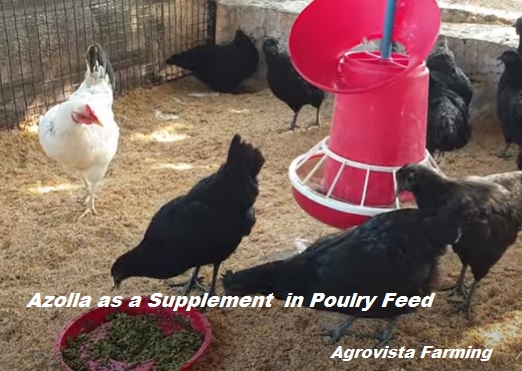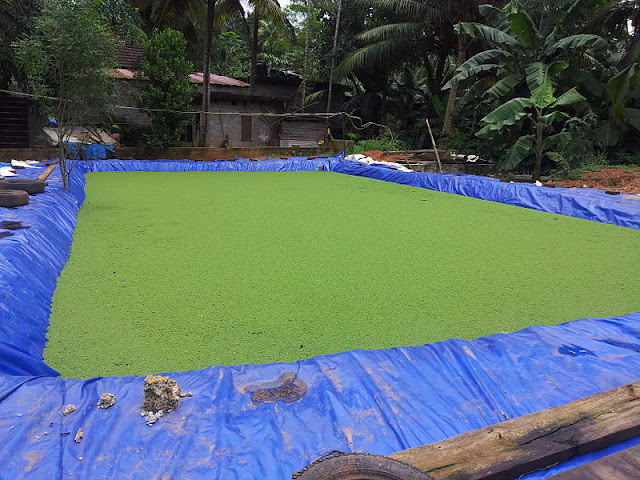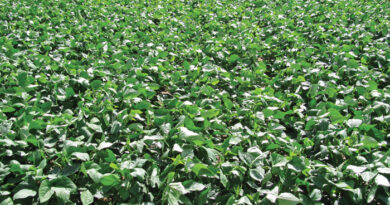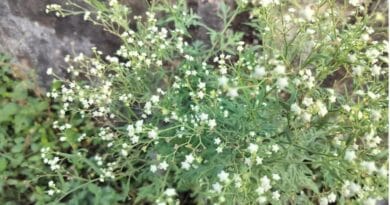Azolla Cultivation – An Opportunity to Increase Farm Income
Azolla is a type of aquatic fern found in temperate climatic conditions; it is very suitable for paddy cultivation. It forms a green carpet over the water. The cyanobacteria:
Blue-green Algae are present with this fern as a symbiont in the lower cavities, which fixes the atmospheric nitrogen with an estimated rate of 25 kg/ha
Azolla can be grown in the flooded field as green fodder for around two to three weeks, and afterward, water from the field is drained, and the collected Azolla is incorporated in the paddy fields at 4-5 quintals/acre. Azolla should be applied in the paddy field after one week of transplanting
Dry Azolla flakes can be used as poultry feed, and green Azolla can be used as fish feed. It is also used as a biofertilizer, a mosquito repellent, in salads, etc. More importantly, Azolla is a good bioscavenger that takes away heavy metals.
Major Advantages of Azolla:
1) It can fix the atmospheric Carbon dioxide and Nitrogen in the form of carbohydrates and ammonia, respectively; after decomposition, it adds the carbon and nitrogen to enrich the soil
2) It can be grown easily in the wild as well as in controlled conditions
3) It can be grown in both Rabi and Kharif seasons as a bio-fertilizer
4) It suppresses the growth of various paddy weeds and checks the excessive evaporation from paddy fields
5) Azolla solubilized various micronutrients, such as Mn, Zn, and Fe, enhancing their availability in the paddy fields.
6) It releases various vitamins and growth regulators, which help in increasing the yield of paddy crops.
7) Azolla releases oxygen during photosynthesis, which helps in the respiration of roots and soil microorganisms.
8) Azolla is a potential ingredient for livestock feeds
Nutritional Value of Azolla
Azolla is a rich source of protein (25% to 30%), calcium (67 mg/100 g), and iron (7.3 mg/100 g) The comparison of Azolla nutrient content with other fodders is as follows:
S. no. |
Items | Annual Production of Biomass In Mt./Hac | Dry Matter Content Mt / Ha | Protein Content (%) |
1 | Hybrid Napier | 250 | 50 | 4 |
2 | Kolakattao grass | 40 | 8 | 0.8 |
3 | Lucerne | 80 | 16 | 3.2 |
4 | Cowpea | 35 | 7 | 1.4 |
5 | Subabool | 80 | 16 | 3.2 |
6 | Sorghum | 40 | 32 | 0.6 |
7 | Azolla | 1000 | 80 | 24 |
Source : Dr P Kamalasanan et al. 2004 “Azolla -A sustainable feed substitute for livestock”, Spice India
Azolla can be a substitute for fodder under fodder scarcity, or it can be used as a supplement to livestock feed at 2–3 kg of Azolla per animal.
Azolla as a feed ingredient in Poultry;
There are two major problems in the growing poultry business:
a) Availability of quality feed
b) Cost of the quality feed
The feed cost incurred in poultry farm production accounts for approximately 60–65% of the total production cost. The water fern Azolla is a good option for protein-fed proteins. The plant-originated protein feed is much less costly than the animal-originated proteins.
Cultivation of Azolla Sp.
Under natural conditions like paddy fields, it is around 50-60 g/sq.m./day, whereas under the control conditions, it may yield up to 400-450 gm/sq.m./day. The production may be further enhanced by reducing the competition from other aquatic plants, and this can be achieved by growing Azolla in separate lined pits
Required Conditions for Azolla Production.
1) It can be grown in warm temperate and tropical conditions in pits, ponds, and wetlands.
2) Azolla mostly prefers shade and 30-35% light for photosynthesis
3) Azolla cultivation prefers a temperature between 15 to 35 degrees Celsius.
4) Higher temperatures negatively affect the growth of the Azolla.
5) The optimum pH range for Azolla should be in the range of 5 – 7.
6) Excessive alkaline or acidic conditions negatively impact the growth of Azolla.
Construction of Pits for Azolla Cultivation;
As we know, the water requirement of Azolla cultivation is quite high; hence, the construction of the pit should be near the water source. As Azolla prefers shady conditions, construction of the pond should be preferred under conditions where the pits receive enough shady environment and also have sufficient exposure to light for photosynthetic activity.
The pits should be easily accessible for proper monitoring. The surface of the pits must have a smooth surface to avoid any damage or puncture on the sheet that is placed at the bottom of a pond.
Size of the pits: The pits should be 0.2 meters in depth and 1.5 meters wide in size so that cultural operation can be performed easily from both sides. As far as the length of the pit is concerned, it depends upon the production requirement of the unit. The polythene sheet should be spread over the pits in such a way that 10 cm of standing water can be maintained easily.
Note: The 2 units of pits of 2.5-meter length with an area of 8 sq. m are sufficient to fulfill 50% of the fodder requirements for the 2 cows.
Production Process of Azolla:
After construction of the pits, spread 15 kg of well-sieved soil over the pit surface. Add 5 kg of well-decomposed cow dung properly mixed with water. This will act as a source of carbon for the Azolla. Now, add the 40 g nutrient mixture containing 10 kg of rock phosphate, 1.5 kg of magnesium salt, and 500 g of murate of potash. Add sufficient water to the pits up to a level of 10 cm and leave it till the soil particles get settled.
Now prepare a fresh Azolla inoculum by adding 2 gms of carbofuran to prevent pest infestation Remove the foam and scum over the water surface and allow it to stand overnight.
The next day, spread the 200 g of inoculum gently on the surface of the water It will take approximately 2 weeks for Azolla to form a carpet over the water’s surface. Ensure sufficient water levels in the pits and cover the pits with the help of nets to provide enough shady conditions, and it will also facilitate the pit to remain clean.
Maintenance Required in Azolla Cultivation ;
The water level must be maintained in the pit by applying water every day. Do not harvest the Azolla in the first seven days; keep fertilizing the soil at 20–25 day intervals by applying 1.5 to 2 kg of cow dung and 80–100 g of SSP once every 15 days. Any litter or weeds in the pit should be removed regularly. The pit should be emptied every 6 months and Azolla cultivation restarted with fresh Azolla culture and soil.
Harvesting of Azolla;
After seven days, Azolla can be harvested @ 1.5 kg per pit per day It should be harvested in plastic trays with the help of sieves. After harvesting, the Azolla should be washed properly to avoid the foul smell of cow dung. The Azolla harvest can be mixed with other feeds in a ratio of 1:1
Read further.
Cultivation of Maize: Zea Mays
Multi-layer farming Model: Objective, Process and Advantages





